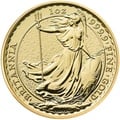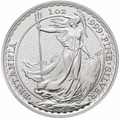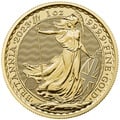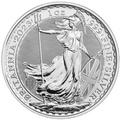Who is Britannia?
Everyone knows that she 'rules the waves', she is on the 50p and £2 coins we use every day, and there was a time in the 1990s when she really was cool, but who is Britannia?
Armed with a trident and shield, and wearing a Corinthian helmet, Britannia is the embodiment of the United Kingdom in female form. The image of this woman has been used to symbolise British national pride, unity and strength for centuries. In older times, Britannia’s strength was particularly associated with British naval power.
As the song goes:
Rule Britannia!
Britannia rule the waves.
Britons never, never, never shall be slaves.
.

Britannia is established in popular culture, as depicted here at the Hastings annual Bonfire procession.
The birth of Britannia
Britannia is typically associated with Queen Boudica or Boadicea; the Celtic Iceni ruler who led a revolt against the rule of the Roman empire. The symbolic figure of Britannia actually predates Boadicea however, to the time when the Romans first occupied land in the British Isles.
The icon was imported into Great Britain with the Roman conquest, and is based on the Roman goddess Minerva; the sponsor of arts, trade, strategy, and wisdom. Minerva was herself the Roman appropriation of the goddess Athena, and both are based upon the ancient Phoenician goddess Barati; recognised in the Indian Vedas as Goddess of the Waters.

An Etruscan bronze statue of the Roman goddess Minerva, whom Britannia was based upon.
The name Britannia is derived from the Latin ‘Britannicae’ , which the Romans used in reference to the British Isles. This was in turn derived from the Greek form ‘Prettanike’ or ‘Brettaniai’ . The inhabitants were named ‘Britanni’ or ‘Britons’ . To this day ‘Prydain’ , from the Greek, is the Welsh translation of Britannia.
It was Emperor Julius Caesar who led the conquest of the British Isles. However, when the Emperor Claudius came to Britain he was portrayed as its conqueror. Following this, 'Britannicus' was added to his name.
As the overseas and furthest territory of the Roman Empire, it soon became identified with the goddess of warfare and water. Thus, the Roman goddess Minerva became Britannia, and the personification of the British Isles.
After the fall of the Roman Empire, England was invaded by the Anglo-Saxons. The original Celtic Britons withdrew to Scotland, Ireland, Wales, and Breton in France. They took with them the heritage of the iconic woman, which was for the time lost from England.

In the 16th and 17th century, under
Queen Elizabeth I,
England extended its naval power and successfully defeated a Spanish invasion. This, combined with a female monarch and growing national confidence, saw a return of Britannia as an image of the English nation's strength.
The Act of Union in 1707 united Scotland, England, Ireland and Wales. This gave further credence to the female imagery as an inclusive symbol of unity to the four nations.
The final assertion of Britannia as the symbol British power came in the reign of another female sovereign,
Queen Victoria.
The power of British industry and naval strength saw Britannia become the ultimate symbol of Victoria's growing British Empire.
Who is Britannia on coins?
After the Ancient Romans established the link between their far flung territories and the goddess, it became common to see Britannia on the Roman British coins. Britannia has therefore been a feature of British coins now for almost 2,000 years!

Roman Siliqua coin depicting Britannia on the reverse or tails.
In A.D. 122, following the expansion of Roman territory, Emperor Hadrian spent time in Britain. Coins were struck to commemorate his visit, including the bronze Sestertius and Siliqua, which featured an image and inscription of Britannia on the reverse. Further coins featuring Britannia were later minted under Antoninus Pius AD 138-160, in bronze and gold with the inscription IMPERATOR II BRITAN.
The female icon on coins departed with the Romans until reappearing 1672. In this year, Charles II chose to reintroduce Britannia onto his coinage. Britannia is depicted on Charles II's copper Halfpennies and Farthings, similar to the Roman coins. However, on these coins she also holds a shield bearing the Union flag in a more nationalist display.

A 1797 penny featuring Britannia, which because of its size was nicknamed the ‘Cartwheel penny’.
Since reintroduction, Britannia has continued to feature on various UK common currency coins. Most notably she featured on Farthings, Halfpenny and one Penny coins following the Great Recoinage of 1816. Today, following decimalisation in 1971, Britannia features on circulating 50p and £2 coins.

The 2015 common currency £2 coin featured a reworking of the classic image by Antony Dufort.
Gold Britannia coins
For many UK investors however, Britannia is best known as the flagship bullion coin of Britain. In 1987, to satisfy a growing demand for bullion coins from both coin collectors and investors, The Royal Mint introduced the gold Britannia coins. These contain one ounce of 24 carat gold (since 2013), and have a face value of £100. Along with the 22 carat Sovereign, they are the UK's leading bullion coins and the first choice of many investors.
As UK legal tender, gold coins such as the Britannia are exempt from Capital Gains Tax. Additionally, all investment gold in the UK and EU is VAT-free. This combines to make the gold coin an attractive financial safe haven investment. The 1987 Britannia proved a great success and The Royal Mint went on to strike
half,
quarter
and
tenth ounce
coins. In 1997 The Royal Mint also added a
silver Britannia coin,
with a £2 face value, which has become the most popular silver coin for investment purposes.
Buying Gold Britannia coins
The design of the Britannia coin has remained largely the same, but there have been unique releases on occasion. BullionByPost sells gold Britannia bullion coins at low premiums including free, fully insured delivery. For those seeking the very lowest prices choose our best value mixed year coins; this will give you the best way to buy a Britannia. For coin collectors or numismatics, we also offer the exact year of Britannia plus other coins feature the iconic figure.
- How To Buy Gold
- How to Buy?
- Payment Options
- Delivery Options
- Gold Storage
- Storage at Brink's
- Gold Investment Guide
- Why buy gold?
- Is gold a good investment?
- Why physical gold?
- Best time to buy gold?
- Gold bars vs coins?
- Gold vs Silver
- Gold - Silver Ratio explained
- VAT on bullion
- CGT on bullion
- Legal tender coins
- Top 5 Gold Investments
- Top 5 Silver Investments
- Gold vs ISAs
- Gold vs Buy-to-Let
- Gold vs FTSE 100
- Gold vs Bitcoin
- Where to buy gold?
- Why buy from us?
- Where to sell gold?
- Coin Shops
- Gold Price Forecasts
- Top 10 Gold Producers
- Top 10 Gold Reserves
- Gold Britannia vs Sovereign
- Britannia coin designs
- Sovereign coin designs
- Sovereign Mintages
- Sovereign mint marks
- British coin specs
- What is a proof coin?
- Royal Mint bullion
- The Queen's Beasts
- Royal Mint Lunar Coins
- Bullion Refiners
- British coin mints
- Krugerrands
- Gold Tola - India & Pakistan
- Bullion Index











